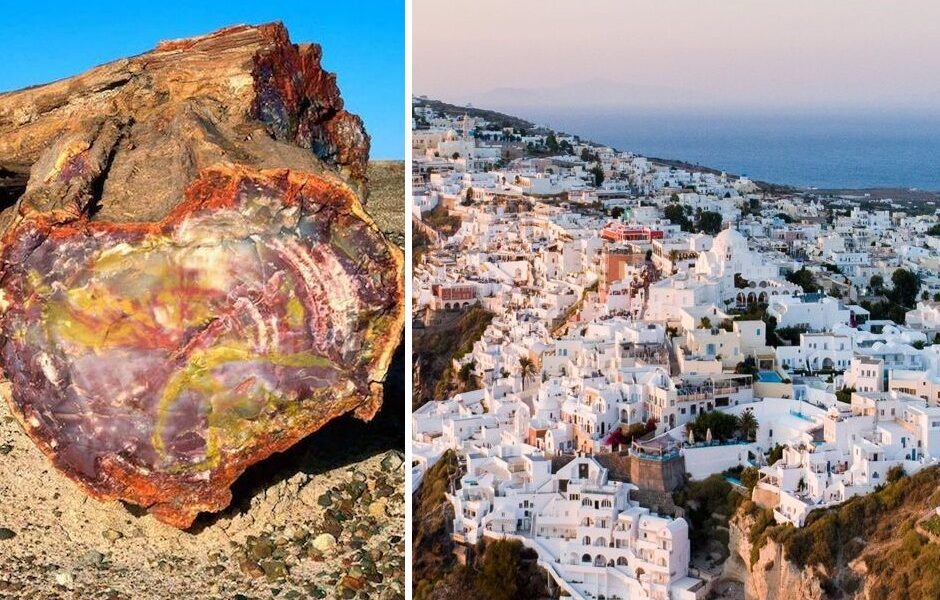October 6 marks World Geodiversity Day, which also means that many locations are evaluated by an International Committee to create a Top 100 World Geological Heritage site list. This year, two sites from Greece made the list: The Petrified Forest of Lesvos and the Volcanic Caldera of Santorini.
The International Union of Geological Sciences, in collaboration with UNESCO, took the initiative to create a list of the top areas of geological interest worldwide.
In this context, the International Geological Congress (IUGS-IGC) implemented an International Program with the aim of recording and evaluating the identification of the first 100 Geological Heritage Monuments.
It should be noted that according to the Commission, a Geological Heritage Site is defined as an area that contains geological elements or geological processes of international scientific scope, which is used as a point of reference or has made a decisive contribution to the development of the Geosciences over time.
- The petrified forest of Lesvos is a preserved natural monument. The nomination was submitted by the Museum of Natural History of the Lesvos Petrified Forest and was prepared by a scientific team consisting of Professor N. Zouro (University of the Aegean), Professor N. Soulakellis (University of the Aegean), and Drs. H. Valiakos and K. Bendana.

- The Caldera of Santorini. The Municipality of Thira co-decided on the submission of a nomination file in collaboration with a scientific team consisting of associate professor P. Nomikou (National and Kapodistrian University of Athens). Dr. X. Fasoulas (Museum of Natural History, University of Crete) and Professor N. Zouros (University of the Aegean).

The first 100 IUGS Geological Heritage Sites will be honoured at a special event organised on the occasion of the 60th anniversary of the founding of the International Union of Geological Sciences in collaboration with UNESCO and the Global Geoparks Network and will take place in Zumaia (Basque Coast, area recognised as a UNESCO World Geopark) in Spain on 25-28 October 2022.
The nomination of the Petrified Forest of Lesvos will be presented by Professor N. Zouros and the nomination of the Caldera of Santorini by Associate Professor P. Nomikou.
Lesvos

The Lesvos Petrified Forest is a rare fossil forest ecosystem that includes large concentrations of petrified trees and animal fossils that were covered by volcanic material 18 million years ago.
Inside layers of volcanic ash are standing and lying fossilised trunks, branches, roots, fruits and leaves of trees as well as fossilised bones and teeth of animals.
Important fossil-bearing areas are also found in the coastal zone and in the marine area west of Lesvos.

In the area of the Petrified Forest you can also find impressive volcanic geosites, which bear witness to the intense volcanic activity in the past. By Presidential Decree (PD 443/1985) the Petrified Forest was declared a conservation monument of nature.

The Lesvos Petrified Forest is one of the four founding members of the European Geoparks Network in 2000 and the Global Geoparks Network in 2004.
It is a geological heritage site that has been used for decades by schools to implement environmental education activities and universities in earth sciences, geohazards and climate change.
Santorini

The caldera of Santorini, with its fascinating geomorphology, the unique volcanic formations that make it up and its amazing geological history, is a focal point worldwide not only for tourism but also scientists, with a multitude of scientists from Greek and International Universities carrying out notable research work in the region.
Its wider promotion and protection, as a result of its successful inclusion in the 100 most important geological monuments worldwide, will give the opportunity to a large number of visitors, as well as to the island's own inhabitants, to appreciate the greatness of our planet in this so important corner of Greece.

Observing the successive layers of lava and ash that built the island over time but also admiring in awe the imposing slopes created as a result of one of the most violent and destructive volcanic eruptions in history, the common man will be able to connect with the Earth to understand and appreciate its power in Santorini.
READ MORE: Samothrace: The most magical natural pools in Greece.


